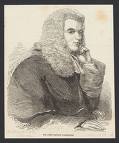
This book is a prosopographical study of the 208 men who ascended to the judicial bench in England between 1727-1875. “Prosopographical??” I hear you ask. My Concise Oxford dictionary defines prosopography as
Description of person’s appearance, personality, social and family connections and career; study of such descriptions.
This is the second prosopographical work I have read, and I really quite enjoy it. (I just want to show off that I can use such a word- I have no idea how to pronounce it, so I’ll just have to write it. ) The first was a book about the Colonial Office and the governors sent to the various colonies (Cell, 1970). Prosopography is not so much descriptions of individuals, as a compilation of multiple biographies to develop a broad sketch of a particular career group. The methodology uses biographies, memoirs, diaries, letters and personal papers to compile statistics about particular life events- birth place, birth order, schooling, occupation, place of residence, income, marital status etc. From this emerges a picture of the “typical” judge or colonial governor which, although of course a generalization, helps to highlight the exceptional and anomolous.
Duman categorizes his judges into five separate time-spans of about 25-30 years which reflect social and professional changes occuring in Britain at the time. He argues that, instead of being a ladder to success for men of lowly means, the law was always the preserve of upper middle-class and middle class men. Landed gentry were not particularly attracted to it as a profession because, unlike the army or church, patronage was of limited use if you were incompetent. There were more certain ways of maintaining one’s status without entering into the lottery of the law. Likewise, lowly families would not have been able to financially support their sons over the decade of insecure and poorly paid idleness, waiting until the briefs started to come in.
Although in the second half of the 19th century the law became more accessible to the sons of merchants and proprietors, the ‘great public schools’ remained the educational nurseries, and Oxford and Cambridge (and later Dublin) remained the main universities attended. The men on the bench may not have been so enmeshed in the landed gentry as they had been in the past, but they were just as much imbued with a belief in the sanctity of private property.
There is barely a mention of the colonial judiciary in this book: instead, these judges are the ones who succeeded ‘at home’. Nonetheless, for colonial judges, the experience of the colonies and the nascent law administrations they encountered was laid over the formative, common experience of the bar back in Britain.
I find this broad-brush depiction of a designated profession in this book quite fascinating. The statistics and generalizations are interspersed with particular case studies, fleshed out with letters and diary entries. The intent is to develop a profile of a class as a whole, which could be a reductionist, disembodying act, but the re-introduction of individuals back into this meta-biography returns it to the realm of the personal again.
References
John W Cell, British Colonial Administration in the Mid-Nineteenth Century: The Policy Making Process, 1970
Daniel Duman The Judicial Bench in England 1725-1875: The Reshaping of a Professional Elite, 1982.
